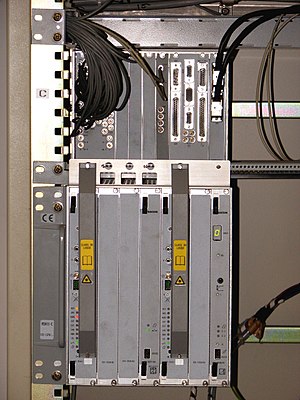This article needs additional citations for
verification. (July 2007) |

An add-drop multiplexer (ADM) is an important element of an optical fiber network. A multiplexer combines, or multiplexes, several lower- bandwidth streams of data into a single beam of light. An add-drop multiplexer also has the capability to add one or more lower-bandwidth signals to an existing high-bandwidth data stream, and at the same time can extract or drop other low-bandwidth signals, removing them from the stream and redirecting them to some other network path. This is used as a local "on-ramp" and "off-ramp" to the high-speed network. [1]
ADMs can be used both in long-haul core networks and in shorter-distance " metro" networks, although the former are much more expensive due to the difficulty of scaling the technology to the high data rates and dense wavelength division multiplexing (DWDM) used for long-haul communications. The main optical filtering technology used in add-drop multiplexers is the Fabry–Pérot etalon.
Newer "multi-service SONET/SDH" (also known as a multi-service provisioning platform or MSPP) equipment has all the capabilities of legacy ADMs, but can also include cross-connect functionality to manage multiple fiber rings in a single chassis. These devices can replace multiple legacy ADMs and also allow connections directly from Ethernet LANs to a service provider's optical backbone. At the end of 2003, sales of multiservice ADMs exceeded those of legacy ADMs for the first time, as the change to next-generation SONET/SDH networks accelerated.
An emerging variety of ADMs that is becoming popular as the carriers continue to invest in metro optical networks are reconfigurable optical add-drop multiplexers (ROADMs).
- ^ "Electrical Engineering Glossary Definition for ADM". Archived from the original on 2008-03-04.
This article needs additional citations for
verification. (July 2007) |

An add-drop multiplexer (ADM) is an important element of an optical fiber network. A multiplexer combines, or multiplexes, several lower- bandwidth streams of data into a single beam of light. An add-drop multiplexer also has the capability to add one or more lower-bandwidth signals to an existing high-bandwidth data stream, and at the same time can extract or drop other low-bandwidth signals, removing them from the stream and redirecting them to some other network path. This is used as a local "on-ramp" and "off-ramp" to the high-speed network. [1]
ADMs can be used both in long-haul core networks and in shorter-distance " metro" networks, although the former are much more expensive due to the difficulty of scaling the technology to the high data rates and dense wavelength division multiplexing (DWDM) used for long-haul communications. The main optical filtering technology used in add-drop multiplexers is the Fabry–Pérot etalon.
Newer "multi-service SONET/SDH" (also known as a multi-service provisioning platform or MSPP) equipment has all the capabilities of legacy ADMs, but can also include cross-connect functionality to manage multiple fiber rings in a single chassis. These devices can replace multiple legacy ADMs and also allow connections directly from Ethernet LANs to a service provider's optical backbone. At the end of 2003, sales of multiservice ADMs exceeded those of legacy ADMs for the first time, as the change to next-generation SONET/SDH networks accelerated.
An emerging variety of ADMs that is becoming popular as the carriers continue to invest in metro optical networks are reconfigurable optical add-drop multiplexers (ROADMs).
- ^ "Electrical Engineering Glossary Definition for ADM". Archived from the original on 2008-03-04.